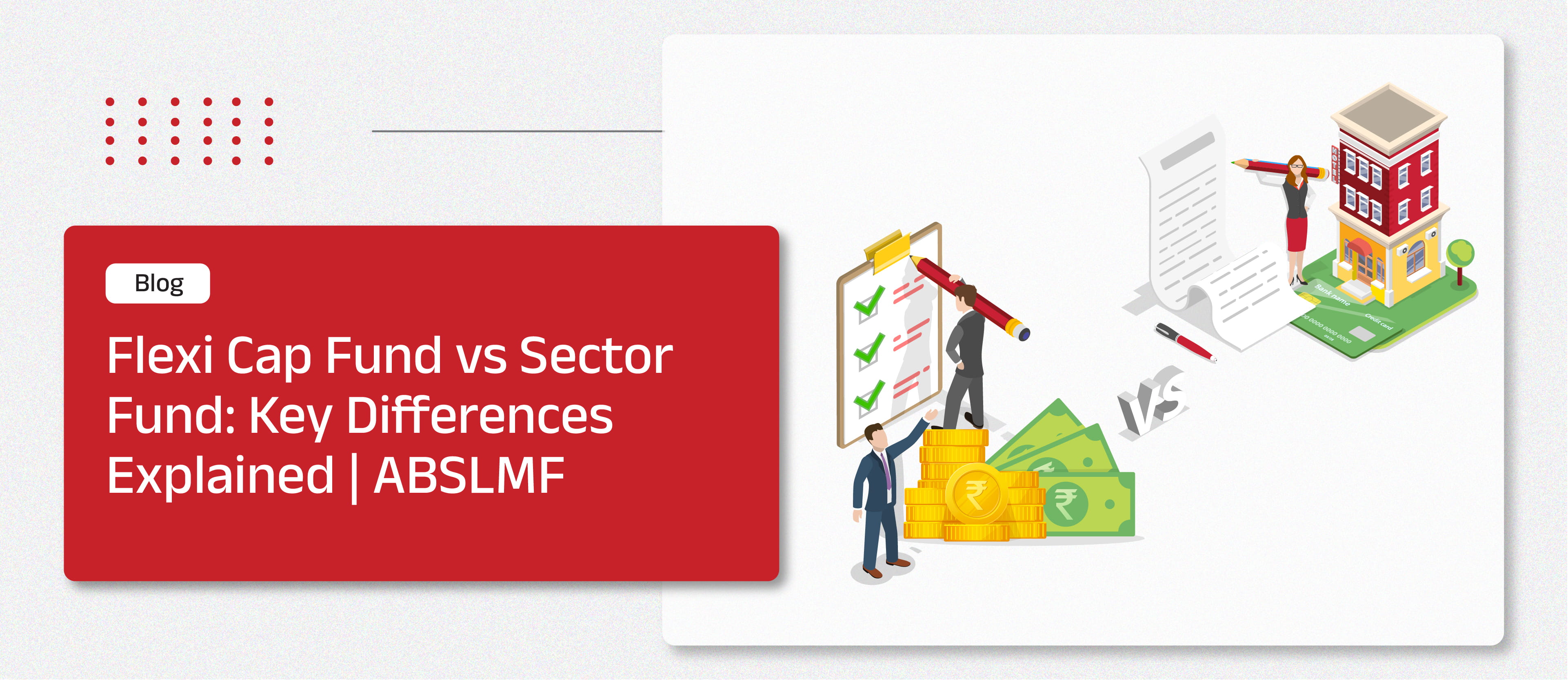-
Our Products
Our FundsFocus Funds
-
Self Care
Self-ServiceFind InformationWays To TransactPartner Solutions
-
Downloads
- Learnings
- About Us
-
More
-
Shareholders
-
Shareholders
-
Updates
-
-
SIP Calculators
- Back
-
Shareholders
Flexi Cap Fund vs Sector Fund: Which is Better for You?

Jun 30, 2025
10 min
0 Rating
Have you ever wondered if you should go broad with your investments or narrow them down? With the popularity of diverse funds surging, people have understood that investing in multiple stock options through them is better than investing in a single one. But the question is, how broad are we talking? Should we invest in the best-performing stocks regardless, or stick to a single sector?
That’s where this flexi cap fund vs sector fund debate comes from. In this article, we will dive into what these 2 are, and which suits you better, based on your goals, risk appetite, and market outlook.
What is a Flexi Cap Fund?
First, let’s understand what is flexi cap fund. Flexi cap funds, which are open-ended equity mutual funds, invest in various market capitalisation categories, including small, mid, and large-cap firms. It gives fund managers the freedom to purchase stocks of any of these businesses in a variety of market caps and industries. This balances risk and return by enabling investors to have a diverse portfolio.
For example, let's say a fund manager distributes the invested sum among specific market sectors. The performance is seen to decline after a while as a result of the state of the market. The fund manager may decide to shift the allocation of funds to another, more profitable industry in such a situation. In this way, investors can profit from the top-performing stocks while simultaneously reducing risk by selling the underperforming equities.
What is a Sector Fund?
Now, let’s understand what is a sector fund. A sector fund is an investment fund that focuses solely on companies operating in a specific industry or economic sector. These funds often take the form of exchange-traded funds (ETFs) or mutual funds. By concentrating on businesses within a chosen sector, sector funds target a particular segment of the market. Each sector consists of companies that provide similar products or services, such as the banking or technology sectors.
Investors use sector funds to make targeted investments in industries they believe will experience growth. While some sectors may have significant growth potential driven by economic factors, these concentrated investments also carry higher risks and increased volatility due to the lack of economic diversification.
Flexi Cap Fund vs Sector Funds: Key Differences at a Glance
Now that we understand what these 2 funds are, we need to understand the differences between the two. The table below explains the differences better.
Parameter |
Flexi Cap Fund |
Sector Fund |
Allocation Strategy |
Diversified across large, mid, and small caps |
Focused on a single sector or theme |
Risk Profile |
Balanced, due to diversification |
High, due to concentration in one sector |
Performance Dependence |
Broad market movements |
Performance of the specific sector |
Fund Manager’s Role |
Highly dynamic shifts across market capitalisations |
Moderate – primarily tracks the chosen sector |
Best Suited For |
Long-term, diversified investors |
Tactical, high-risk investors with sector conviction |
Market Cycle Resilience |
Generally stable across market phases |
Cyclical – may underperform outside sector booms |
When to Choose a Flexi Cap Fund?
Now that we understand what these two funds are and the differences between the two, it’s time to understand when you should invest in which one. While Flexi Cap mutual funds are generally considered high risk when compared to Sector Funds, they are of a far lower risk profile. If you’re a first-time investor or someone seeking to diversify their market in their portfolio, a flexi cap fund is the perfect choice.
Additionally, if your goal is long-term, like retirement or wealth creation, this fund is phenomenal in that case. Considering its diversity, it can survive volatile market conditions easily. If you’re a seasoned investor, it’s also a phenomenal choice if you plan on using a core portfolio component.
When to Choose a Sector Fund?
Now, if you have a high risk appetite and knowledge about a certain sector, then investing in Sector funds is a better choice. They come with a lot of volatility at times, but will outperform any other fund if the sector it is associated with booms due to market trends.
However, it requires exceptional entry and exit discipline; timing it correctly can give unparalleled returns.
Real-World Performance & Volatility Trends
When you look at funds in different market cycles, you get an idea of how much flexi-cap funds and sector funds differ. For example, during COVID-19, when the market was at an all-time low, pharma sector funds received tremendous returns owing to the funding going towards COVID-19 care.
Similarly, when the world was digitised and the IT sector saw a massive boom, but when these sectors hit their peak and tailwind, the market corrections gave this fund a big red. However, flexi Cap funds in general have shown better stability over a period of time. For example, many flexi-cap funds maintained relatively steady returns by pivoting towards defensive or large-cap holdings.
The best flexi-cap fund and sector fund advice that someone will give you is to invest in both, with one giving tremendous returns at high risk and the other being a haven. Having a balance between both funds will give you the best possible results in the market.
Conclusion: Which Fund Is Better for You?
Flexi Cap funds are relatively safer, Sector funds also have the potential to generate better returns. Maintaining a balance between both the funds is most important, as flexi cap funds can be a cushion from the bad times, while sector funds can generate insane wealth if the market is booming in that sector.
The sector(s)/stock(s)/issuer(s) mentioned in this presentation do not constitute any research report/recommendation of the same and the Fund may or may not have any future position in these sector(s)/stock(s)/issuer(s).
Mutual Fund investments are subject to market risks, read all scheme related documents carefully.





 1800-270-7000
1800-270-7000



